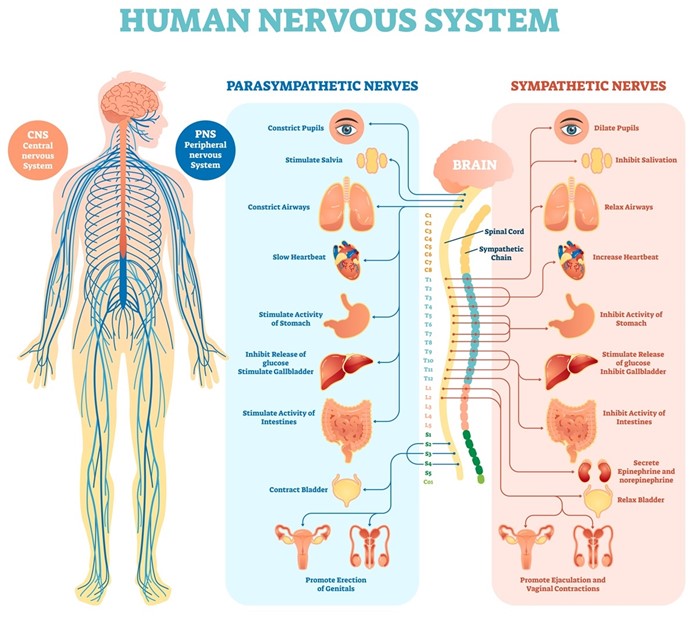INTRODUCTION
- The nervous system is composed of two main divisions: the central nervous system (CNS) and the peripheral nervous system (PNS)
- The CNS consists of the brain and spinal cord, which are responsible for processing sensory information, generating motor commands, and regulating cognitive and emotional functions
- The PNS consists of the cranial and spinal nerves, which connect the CNS to the rest of the body and transmit sensory and motor signals
- The PNS is further divided into two subdivisions: the somatic nervous system (SNS) and the autonomic nervous system (ANS)
- The SNS controls voluntary movements of skeletal muscles and provides sensory feedback from the skin, joints, and muscles
- The ANS regulates involuntary functions of smooth muscles, cardiac muscles, and glands. It has two branches: the sympathetic nervous system (SNS) and the parasympathetic nervous system (PNS)
- The SNS prepares the body for stress or emergency situations by increasing heart rate, blood pressure, respiratory rate, and blood glucose levels. It also dilates the pupils, bronchi, and blood vessels to skeletal muscles
- The PNS restores the body to a state of rest and relaxation by decreasing heart rate, blood pressure, respiratory rate, and blood glucose levels. It also constricts the pupils, bronchi, and blood vessels to skeletal muscles
- The nervous system is composed of two main divisions: the central nervous system (CNS) and the peripheral nervous system (PNS)
- The CNS consists of the brain and spinal cord, which are responsible for processing sensory information, generating motor commands, regulating autonomic functions, and performing higher cognitive functions
- The PNS consists of the cranial nerves, spinal nerves, and peripheral nerves, which connect the CNS to the rest of the body and transmit sensory and motor signals
- The nervous system is composed of two types of cells: neurons and glial cells
- Neurons are specialized cells that generate and conduct electrical impulses along their axons
- Glial cells are supportive cells that provide insulation, nutrition, protection, and repair for neurons
- The nervous system is vulnerable to various diseases and disorders that can affect its structure or function
- Neurological disorders can be classified into four main categories: neurodegenerative diseases, neuroinflammation, epilepsy and seizure disorders, and others (such as trauma, stroke, tumors, infections, etc.)
- Neurological disorders can have significant impacts on the physical, mental, emotional, social, and occupational aspects of a patient’s life
- Nursing care for patients with neurological disorders requires a comprehensive assessment, diagnosis, planning, implementation, and evaluation of interventions that address the patient’s needs and goals
- The nervous system is composed of two types of cells: neurons and glia
- Neurons are specialized cells that transmit electrical impulses and chemical signals
- Glia are supportive cells that provide insulation, protection, nutrition, and regulation for neurons

Nursing Test Bank
Quiz #1: RN Exams Pharmacology Exams
Quiz #2: RN Exams Medical-Surgical Exams
Quiz #3: RN Exams Fundamentals Exams
Quiz #4: RN Exams Maternal-Newborn Exams
Quiz #5: RN Exams Anatomy and Physiology Exams
Quiz #6: RN Exams Obstetrics and Pediatrics Exams
Quiz #7: RN Exams Fluid and Electrolytes Exams
Quiz #8: RN Exams Community Health Exams
Quiz #9: RN Exams Promoting Health across the lifespan Exams
Quiz #10: RN Exams Multidimensional care Exams
Naxlex Comprehensive Predictor Exams
Quiz #1: Naxlex RN Comprehensive online practice 2019 B with NGN
Quiz #2: Naxlex RN Comprehensive Predictor 2023
Quiz #3: Naxlex RN Comprehensive Predictor 2023 Exit Exam A
Quiz #4: Naxlex HESI Exit LPN Exam
Quiz #5: Naxlex PN Comprehensive Predictor PN 2020
Quiz #6: Naxlex VATI PN Comprehensive Predictor 2020
Quiz #8: Naxlex PN Comprehensive Predictor 2023 - Exam 1
Quiz #10: Naxlex HESI PN Exit exam
Quiz #11: Naxlex HESI PN EXIT Exam 2
Questions on INTRODUCTION
Correct Answer is B
Explanation
This is a correct statement. The sympathetic nervous system (SNS) prepares the body for stress or emergency situations by increasing heart rate, blood pressure, respiratory rate, and blood glucose levels. It also dilates the pupils, bronchi, and blood vessels to skeletal muscles.
Correct Answer is ["A","B","C","E"]
Explanation
This is a correct answer. A spinal cord injury at the level of T6 affects the autonomic nerves that innervate the sweat glands and thermoregulatory centers, resulting in decreased sweating and shivering.
Correct Answer is D
Explanation
This is a correct answer. The nurse should use therapeutic communication techniques such as exploring feelings, reflecting, and active listening to provide emotional support and establish rapport with the client.
Correct Answer is A
Explanation
<p>This is an incorrect answer. Glia cells do not destroy pathogens and foreign substances in the nervous system. This is the function of microglia, which are a type of immune cells that reside in the nervous system and act as macrophages.</p>
This is an incorrect answer. An atonic seizure (also known as a drop attack) is characterized by sudden loss of muscle tone, resulting in falling or collapsing.
This is an incorrect answer. Performing passive range of motion exercises can increase ICP by stimulating the sympathetic nervous system, which increases blood pressure and cerebral blood flow.
This is an incorrect answer. Decreased serum sodium level can occur.
This is a correct answer. Monitoring the client for orthostatic hypotension helps to prevent falls and injuries. Orthostatic hypotension is a common complication of Parkinson's disease and its medications, which can cause a sudden drop in blood pressure when changing positions. The nurse should inst
Search Here
Related Topics
More on Nursing
- Pathophysiology of the Musculoskeletal System
- Pathophysiology of the Reproductive System
- Pathophysiology of the integumentary system
- Pathophysiology of the Hematologic System
- Pathophysiology of the respiratory system
- Pathophysiology of the renal system
- Pathophysiology of the Gastrointestinal System
- Basic Concepts of Pathophysiology
Free Nursing Study Materials
Access to all study guides and practice questions for nursing for free.
- Free Nursing Study Trials
- Free Nursing Video tutorials
- Free Nursing Practice Tests
- Free Exam and Study Modes
- Free Nursing Revision Quizlets
